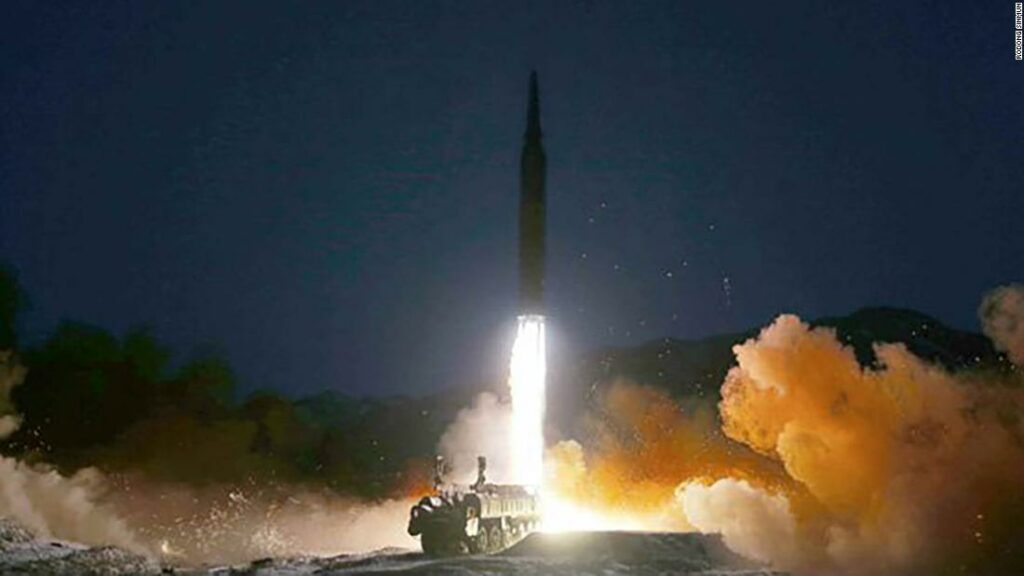Early warning systems first suggested North Korean missile could hit US, causing temporary scramble

It was “ugly,” one US lawmaker briefed on the launch said. Defense officials “didn’t have a good feel for its capabilities” right away, this person added. Initial telemetry readings — which can be inaccurate and are often discarded as more data becomes available — suggested that the missile could pose a threat as far away as the Aleutian Islands off Alaska or the California coast, two sources familiar with the matter told CNN. Within minutes, US Northern Command and the Northern American Aerospace Defense Command (NORAD) dismissed those initial readings and assessed that the missile posed no direct threat to the mainland of the United States. The test weapon — which sources say was a less maneuverable version of a hypersonic glide vehicle designed to evade missile defenses — splashed down harmlessly in the sea between China and Japan, thousands of miles away from threatening America. But in those few moments of uncertainty, the situation escalated quickly enough that the Federal Aviation Administration, which is part of a routine interagency discussion whenever there is a missile launch of this kind, grounded some planes on the West Coast around 2:30 p.m. PST on Monday for about 15 minutes.The grounding forced air traffic controllers to hold some aircraft on the ground, while briefly diverting others in the air, according to air traffic control recordings, but controllers were at a loss when asked to explain to pilots what had caused the grounding. Some controllers erroneously referred to it as a national ground stop, something which hasn’t been seen since 9/11.The question, now, is what sparked that initial burst of urgency — and perhaps, why the FAA reacted the way that it did. “What we’re seeing here is just the normal process of coordination and communication out of which early on some decisions were made that probably didn’t need to get made,” Defense Department spokesman John Kirby told reporters on Thursday afternoon. NORAD insists that it was the FAA’s call to issue the ground stop and that it did not issue a warning or alert as a result of the North Korean missile launch.”As a matter of precaution, the FAA temporarily paused departures at some airports along the West Coast,” the FAA said in a statement on Tuesday. “The FAA regularly takes precautionary measures. We are reviewing the process around this ground stop as we do after all such events.”The FAA did not respond to CNN’s multiple requests for comment on Thursday.A US official said the ground stop was not communicated through the FAA’s Air Traffic Control System Command Center, based in Warrenton, Virginia, and instead went straight to regional centers on the West Coast. The launch on Tuesday was the second such launch by North Korea within the space of a week. But the first, last Thursday, was far less sophisticated, South Korean officials have said. US officials are still conducting their assessment of the most recent test, but analysts who closely track North Korea’s weapons development programs have identified the missile used on Tuesday as what is known as a “maneuverable reentry vehicle” — still a hypersonic glide vehicle that can alter course after reentering the atmosphere but that has a limited range and maneuverability compared to more advanced systems. “It’s basically falling,” said Jeffrey Lewis, a weapons expert and professor at the Middlebury Institute of International Studies. “It’s falling with style.”Lewis said it’s not unusual for detection systems such as radar or infra-red satellites to struggle to determine a missile’s trajectory in the first moments after a launch. “If it’s a regular old ballistic missile, they can usually calculate that pretty well, but you have to wait for the engine to stop firing,” he said. “So that’s why you sometimes see mistakes, because you’re trying to calculate it before the engine stops firing, and if you’re at a funny angle, you might be able to see that it’s going up but not what direction.”In any case, there is no question that the launch violated UN Security Council resolutions that prohibit North Korea from any ballistic missile activity. And arms control experts have continued to raise alarms that Pyongyang’s weapons development program continues to pose a long-term threat to the United States and its allies. US officials familiar with North Korea’s weapons development programs say Pyongyang’s efforts to develop hypersonic missiles is not a surprise — North Korea has telegraphed its intent publicly — even if some of the specific capabilities demonstrated by the missile launched on Tuesday were surprising. Those sources declined to specify what capabilities were unknown. In January of last year, North Korea stated publicly that it had “finished research into developing warheads of different combat missions including the hypersonic gliding flight warheads for new-type ballistic rockets and was making preparations for their test manufacture.”Still, after years of high-profile diplomatic exchanges between former President Donald Trump and North Korean leader Kim Jong Un, the Biden administration has so far taken a relatively low-key approach to North Korea even as it has continued to condemn testing by Pyongyang.CNN’s Natasha Bertrand and Pete Muntean contributed to this report.






